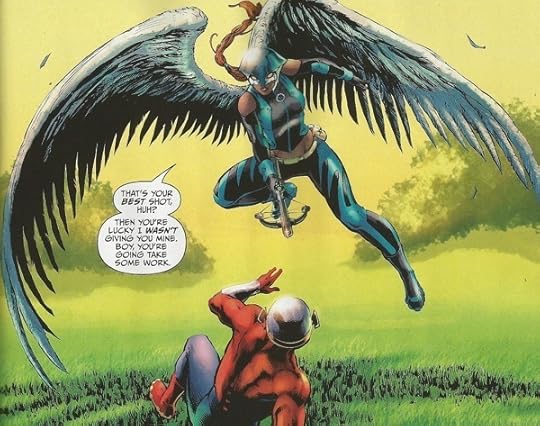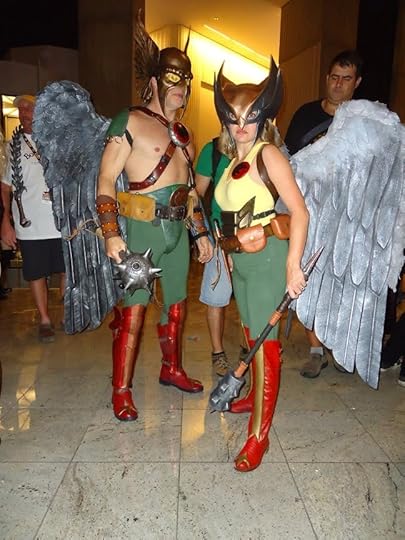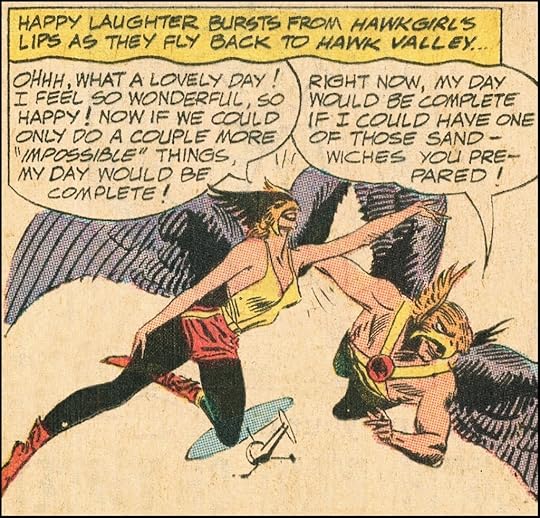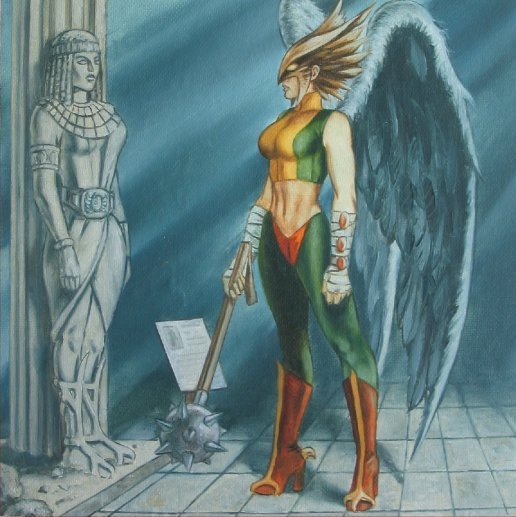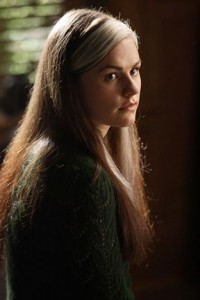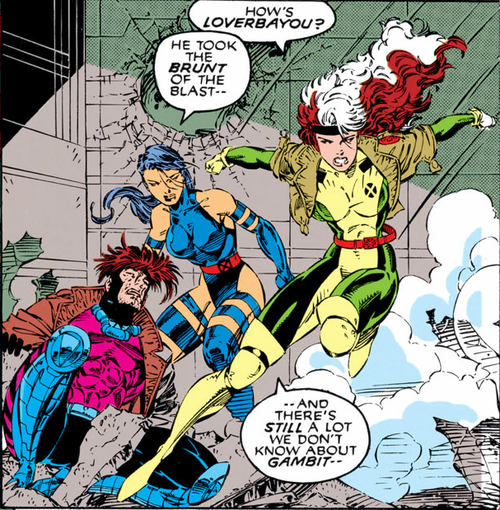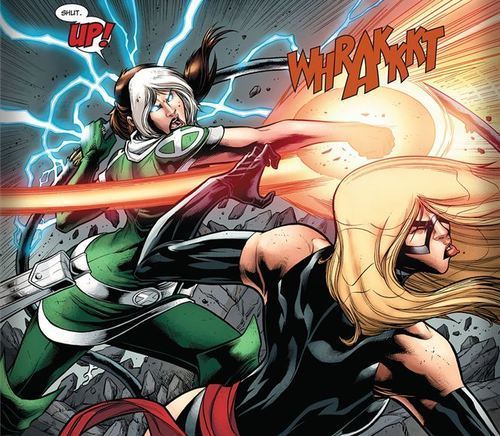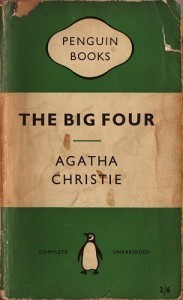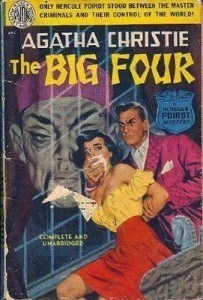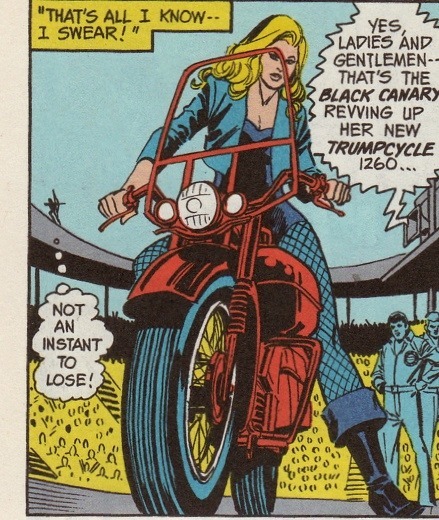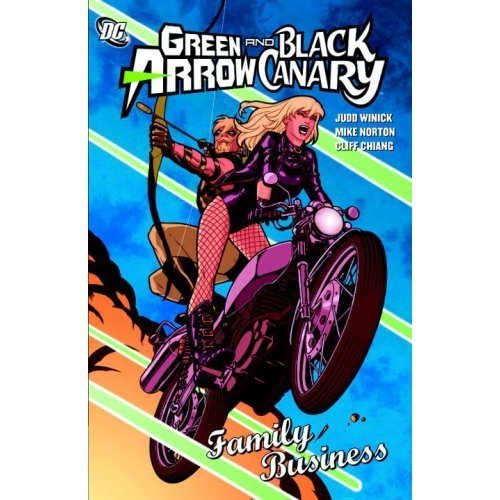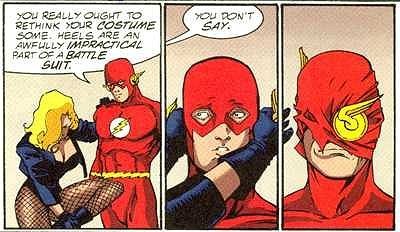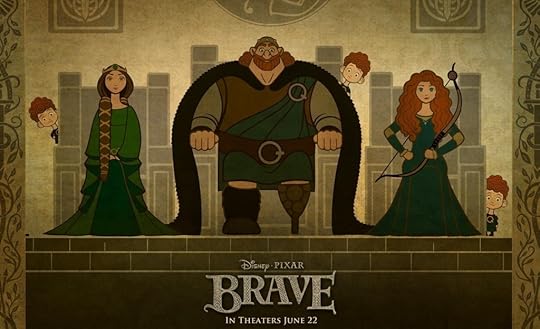Tansy Rayner Roberts's Blog, page 107
July 13, 2012
Where the Wonder Women Are: #3 Hawkgirl/Hawkwoman
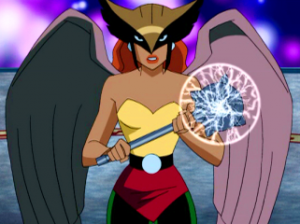 Every time I hear someone talking about how you can’t possibly separate the character of Wasp in the Avengers from that of her far-less-interesting husband Hank Pym (Ant Man/Giant Man), I want to throw Hawkgirl at them. Hawkgirl and her mighty spiked mace.
Every time I hear someone talking about how you can’t possibly separate the character of Wasp in the Avengers from that of her far-less-interesting husband Hank Pym (Ant Man/Giant Man), I want to throw Hawkgirl at them. Hawkgirl and her mighty spiked mace.
In the dim mists of DC continuity, Shayera (or Shiera) Sanders/Hall came as a pair with her husband Carter/Katar Hall who is, you guessed it, Hawkman. They have wings, and they hit things. Sometimes they’re aliens, sometimes they’re cops, sometimes they’re reincarnated Egyptian gods, but mostly they have wings and hit things.
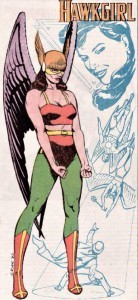 I missed the Golden Age years (characterised largely by the reincarnated Egyptian backstory) and first came across the feathered husband-and-wife duo in the 70’s-80’s pre-Crisis Justice League, otherwise known to me as “Godiyeva’s Black and White Comics Collection.” This comics collection belonging to my friend & comics enabler of 20+ years (now the mother of 3 superhero-obsessed boys who are my daughters’ closest friends) is also the reason that I thought Poison Ivy was blonde for the longest time, and why I will always ship Barry Allen with Zatanna. BUT I DIGRESS.
I missed the Golden Age years (characterised largely by the reincarnated Egyptian backstory) and first came across the feathered husband-and-wife duo in the 70’s-80’s pre-Crisis Justice League, otherwise known to me as “Godiyeva’s Black and White Comics Collection.” This comics collection belonging to my friend & comics enabler of 20+ years (now the mother of 3 superhero-obsessed boys who are my daughters’ closest friends) is also the reason that I thought Poison Ivy was blonde for the longest time, and why I will always ship Barry Allen with Zatanna. BUT I DIGRESS.
The main point of Hawkman, as far as I could see back in those Silver Age comics, was to argue with Green Arrow. He was set up as conservative to Green Arrow’s rich boy liberal and yes, they argued about politics. A lot. It was their thing. Shayera, meanwhile, got to roll her eyes and sometimes would fly around and hit things, alongside her husband. They were a pair of intergalactic cops from the planet Thanagar, though I didn’t see much of that in the Justice League comics where I mostly came across them. As well as not being able to settle on a first name, Shayera/Shiera often switches between Hawkgirl and Hawkwoman, depending on the sensibilities of the production team of the time, and not (of course) the actual age of the character.
I next came across the characters, still as a Married Super Couple™ in the mid-90’s era of Let’s Confuse Everybody Justice League where, prior to Zero Hour, one of many DC Universe Reboots, dozens of different versions of various characters poured out of the woodwork, arguing with each other and wearing slightly different costumes. Hawkgirl and Hawkman were the poster children of this madness, shifting through so many possible alternative versions that it made the reader (me) both dizzy and bored. Apparently Hawkgirl died in that storyline, which I didn’t even remember! I *do* remember that it was far less about her than it was about him, and that the comic of the time was called Hawkman, not Awesome Married Hawkpeople or anything along those lines.
 BUT THEN something wonderful happened, and that wonderful thing was the animated series Justice League. Recognising that it would be utterly stupid in this day and age to have a superhero team with only one female character (Wonder Woman) on it, (NOT LOOKING AT ANYONE, CURRENT JUSTICE LEAGUE), they decided to reboot Hawkgirl without her boring husband, with a snarky attitude and a really big electrified spiked mace.
BUT THEN something wonderful happened, and that wonderful thing was the animated series Justice League. Recognising that it would be utterly stupid in this day and age to have a superhero team with only one female character (Wonder Woman) on it, (NOT LOOKING AT ANYONE, CURRENT JUSTICE LEAGUE), they decided to reboot Hawkgirl without her boring husband, with a snarky attitude and a really big electrified spiked mace.
This Shayera, free and clear of the tangled weight of decades of DC continuity, was just plain awesome. She was an angry, tough warrior woman, in contrast to the slightly calmer but similarly ruthless Wonder Woman. And yes, she was not only an alien from the planet Thanagar, but also a reincarnated Egyptian goddess, which worked just fine.
Carter/Katar Hall turned up in one story, which flirted with the idea of matching her up with her reincarnated/destined husband, but twisted the tale by showing that actually, they were never that good together. Booyah! (Sorry, past Shayera, but your taste in men wasn’t that great)
Hawkgirl’s most significant storyline, in which she has to choose between her own people and the Justice League, then has to suffer the consequences of her choice, was probably the most interesting and characterific thread in this early Justice League series. Shayera was later one of the regulars in the expanded Justice League Unlimited series, which continued to explore her damaged relationships with her colleagues, and her on again off again relationship with John Stewart (AKA the black Green Lantern, whose role in the animated series makes him one of the best known characters to hold that title outside the comics).
John Stewart at one point meets his future son, Warhawk, which is a bit of a giveaway that he and Shayera will get together again someday, but they hadn’t got there yet when the show ended. She and her mace were always the best couple of them all, in any case. HAWKGIRL SMASH!
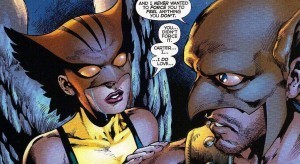 In fact-checking for this post, I discovered another Hawkgirl, Kendra Saunders, who not only had her own series but was written at one point by Jimmy Palmiotti and Justin Gray, who are up there in my shortlist of awesome male writers who write superwomen extremely well. Apparently she has the memories of Shiera Hall (Golden Age Hawkgirl, the one who’s all about the reincarnations) which made for awkward tension and a kind of twisted romance with Hawkman. I was intrigued right up until until Wikipedia told me that Kendra was killed off in the Blackest Night storyline so that Hawkman and the *real* Hawkgirl, Shiera, could be resurrected together. Boo! Then after all that Shiera got killed off again, to add to Hawkman’s manpain. BOOOOOO!
In fact-checking for this post, I discovered another Hawkgirl, Kendra Saunders, who not only had her own series but was written at one point by Jimmy Palmiotti and Justin Gray, who are up there in my shortlist of awesome male writers who write superwomen extremely well. Apparently she has the memories of Shiera Hall (Golden Age Hawkgirl, the one who’s all about the reincarnations) which made for awkward tension and a kind of twisted romance with Hawkman. I was intrigued right up until until Wikipedia told me that Kendra was killed off in the Blackest Night storyline so that Hawkman and the *real* Hawkgirl, Shiera, could be resurrected together. Boo! Then after all that Shiera got killed off again, to add to Hawkman’s manpain. BOOOOOO!
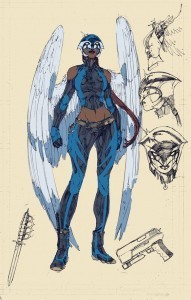 There’s a happy ending. I hope? The Justice Society, formerly the original 1940’s super team, then the Earth 2 super team, then the old fogeys super team, now back to being the Earth 2 super team now that WE HAVE EARTH 2 BACK (aww, DC, don’t ever change…) has been revamped and rebooted. The various members are being reimagined as hot, contemporary young characters. Alan Scott is gay, Jay Garrick is a hapless teen on the run, and Hawkgirl is back as a black Kendra Saunders. Her nationality isn’t established yet, but I’m kind of hoping for Egyptian…
There’s a happy ending. I hope? The Justice Society, formerly the original 1940’s super team, then the Earth 2 super team, then the old fogeys super team, now back to being the Earth 2 super team now that WE HAVE EARTH 2 BACK (aww, DC, don’t ever change…) has been revamped and rebooted. The various members are being reimagined as hot, contemporary young characters. Alan Scott is gay, Jay Garrick is a hapless teen on the run, and Hawkgirl is back as a black Kendra Saunders. Her nationality isn’t established yet, but I’m kind of hoping for Egyptian…
So far in Earth 2, Hawkgirl hasn’t done much more than snark at Jay Garrick’s ineptitude as a superhero and shoot at him a bit (he had it coming) and in fact we only have Wikipedia’s word for it that she’s Kendra at all since she has only introduced herself by her alias, but she has awesome metallic wings and is drawn by Nicola Scott, which is enough for me to think that this particular Hawkgirl is worth paying attention to.
As long as, you know, she’s not the ONLY woman on the team. Because that would be beyond stupid in this day and age, right, Justice League? RIGHT?
Where the Wonder Women Are:
0: Introduction
1: Black Canary
2: Rogue
3: Hawkgirl/Hawkwoman
July 12, 2012
Friday Links Shouts “Bye Bye Duggan” Off The Eiffel Tower
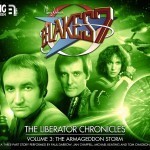 So, Big Finish started making new Blake’s 7 stories. And I was excited. And then they decided to pull out all the stops for a full cast audio, and I was really excited. But now… HOLY HELL, PEOPLE! They’ve brought in Tom Chadbon (AKA Duggan from Doctor Who’s City of Death) as Del Grant, brother to Anna Grant, for a 3 part action extravaganza set AFTER the Season 3 Anna Grant episode.
So, Big Finish started making new Blake’s 7 stories. And I was excited. And then they decided to pull out all the stops for a full cast audio, and I was really excited. But now… HOLY HELL, PEOPLE! They’ve brought in Tom Chadbon (AKA Duggan from Doctor Who’s City of Death) as Del Grant, brother to Anna Grant, for a 3 part action extravaganza set AFTER the Season 3 Anna Grant episode.
If you don’t know why that is the most exciting thing someone could possibly tell me this week, then you are not living inside my head.
But wait, there’s MORE excitement. Because after a week of hand-wringing and general Gooner misery concerning the impending loss of another beloved captain (slightly less beloved now), they’ve revealed the new away kit, and it’s not blue, it’s not yellow, OH BABY take a look at those purple stripes.
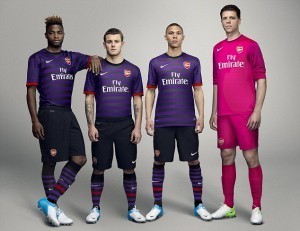 I was sad about the coming season and now I am not. Raeli has two Arsenal kit tops, one red and one yellow. I am TOTALLY buying Jem this one. Purrrrrple.
I was sad about the coming season and now I am not. Raeli has two Arsenal kit tops, one red and one yellow. I am TOTALLY buying Jem this one. Purrrrrple.
Kirstyn McDermott has written a great analysis of The Cabin in the Woods, the cult of Joss Whedon, and why we should hold our feminist heroes to higher standards.
Doctor Nerd Love talks about the vile misogynist attacks on Anita Sarkeesian, culminating recently in a flash game in which players can physically beat her, designed by a man who said it was justified because she wouldn’t publish his comments on her site. A measured, intelligent article.
Justine Larbalestier, returning to blogging this month, talks about the difference between editing and rewriting, and why good editors don’t do the writing for you.
Tor.com on why Monkeybrain Comics are a big deal, and worth checking out. I am certainly going to try out some of those titles!
The Love2Read writing contest is on again – looking for stories about learning to read as an adult, with some substantial cash prizes. I was one of the winners of this last year and am delighted to hear that it’s on again – great opportunity for Australian writers.
Grant Watson looks at the sales and success of Wonder Woman before and after the New 52 Reboot.
CAL has announced an upcoming website devoted to the appreciation and study of 200 Australian books.
Jane Brocket on reading Virginia Woolf’s novels.
Voices and Angels – my night at MONA
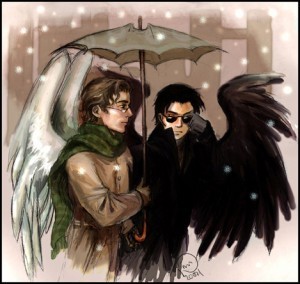 Last night we got to attend “Angel Story,” one of the events as part of the current Festival of Voices, at MONA. I feel like a bad Tasmanian for this being my first time inside the swish high art museum since its revamp (I was hardly out of the place when it was a classics museum) several years ago – and was beginning to feel like we were the only people in the world who hadn’t been there!
Last night we got to attend “Angel Story,” one of the events as part of the current Festival of Voices, at MONA. I feel like a bad Tasmanian for this being my first time inside the swish high art museum since its revamp (I was hardly out of the place when it was a classics museum) several years ago – and was beginning to feel like we were the only people in the world who hadn’t been there!
We got as far as the grounds last summer, for my godson’s 4th birthday, but with a horde of tired and sticky children, didn’t quite feel adventurous enough to go inside.
So there I was last night, glammed up, walking around this bizarre structure, all glass and sandstone edifices, surrounded by a whole bunch of art patrons, and I didn’t manage to take a single photo. Sorry!
The event itself was a theatrical presentation of three stories that had won the Angel story competition – including my own! It was staged in the Nolan Room, which is an extraordinary exhibit all of its own – his famous painting-of-many-paintings is displayed along its long, curving wall (I took one look and said “it’s a quilt”).
The stories were read by local actors, all women, who did marvellous jobs. I was particularly taken by the performance of the first story, “Breathless,” an utterly dynamic reading. A soundscape including effects, music and electronic chorus was provided by Moira Smiley and VOCO – the acoustics were amazing and the overall sensation very eerie and effective.
My story was last. Which freaked me out a little bit. I’ve had my stories read by others before, but never like this – a fully acted performance, with audio background, and a live audience responding quite vocally to the story which it turned out is a lot funny than I remembered (until the last act, HA, stunned silence all around). I got to eavesdrop people talking about my story afterwards, which was utterly bizarre – like Goodreads but REAL LIFE, you know? I think I possibly started a minor flamewar by depicting an angel smoking cigarettes… oops?
I find it mildly hilarious that considering the theme was ‘angels,’ none of the stories were remotely religious, even the one that quoted from the bible.
It’s rare enough for my honey and I to get out among adults in the real world, but this really was a unique experience! And yet again a reminder that you don’t have to live in a big city to have an awesome arts scene. Thanks to Island Magazine, the Festival of Voices and MONA for making it happen.
July 11, 2012
Where the Wonder Women Are: #2 Rogue
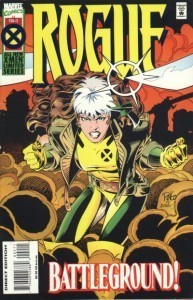 Rogue was the first Marvel super heroine I discovered, thanks to the animated X-Men series of the early 90’s (which I’m currently rewatching with my daughters).
Rogue was the first Marvel super heroine I discovered, thanks to the animated X-Men series of the early 90’s (which I’m currently rewatching with my daughters).
I adored that series, but could never find the comics to match it – I had a fairly scattershot approach to comics buying and reading in those days, and was limited by what I could find in second hand bookstores and our lone comic shop (later there were TWO in Hobart, then one again, and I remember the thrill of the chase when I got a rare chance to travel around the other state and find OTHER shops selling comics). Before the internet, wikipedia and an arsenal of graphic novels in the local library, finding comics with specific characters was HARD.
I know now that the TV series I loved was based pretty heavily on the X-Men comics of 10-15 years previously, and that the Marvel comics of the 90’s were famously quite continuity-heavy, which explains why whenever I picked one up, it was full of completely different characters, involved in complex storylines I didn’t understand.
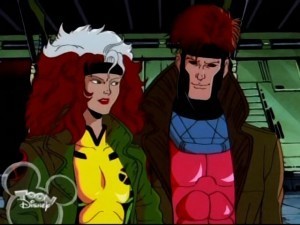 So for a long time, my Rogue was the young woman I saw in the TV series – and there was plenty for me to latch on to as a teen viewer. She was angsty, angry, and powerful, she had a flirtatious romance with the brooding/banterific Gambit whom she couldn’t even kiss because of her powers, and no one understood her! Thinking about it now, I probably also empathised a lot with her streaks of white hair in the brown, as mine was doing the same thing before I left high school. I soon gave up on hunting X-Men comics, but I still collected ones I found with Rogue, and even bought her mini-series brand new when it was released.
So for a long time, my Rogue was the young woman I saw in the TV series – and there was plenty for me to latch on to as a teen viewer. She was angsty, angry, and powerful, she had a flirtatious romance with the brooding/banterific Gambit whom she couldn’t even kiss because of her powers, and no one understood her! Thinking about it now, I probably also empathised a lot with her streaks of white hair in the brown, as mine was doing the same thing before I left high school. I soon gave up on hunting X-Men comics, but I still collected ones I found with Rogue, and even bought her mini-series brand new when it was released.
One of the big differences between the DC and Marvel comics “universes” is Metahuman vs. Mutant. DC has never really explained why its universe produces so many “metahumans”, instead coming up with a separate, specific reason for each super-powered character whether that be alien origins, laboratory accident, power rings, and so on. While Marvel has its share of these specific origin stories, it also includes the ongoing story of the mutant gene, and the idea that humanity is producing a large number of natural and spontaneous superhumans – a fact which freaks many people the hell out.
All manner of consequences to these mutations have been explored in the Marvel Universe, in various interesting narrative ways. Tolerance and bigotry are themes that come up over and over again in relation to the Marvel mutants in general, and the X-Men in particular. The mutants themselves tend to form factions, most famously divided by the rhetoric of Magneto, who believes mutants are superior to humans and should replace them, and that of Professor X who believes mutants and humans should co-exist in harmony.
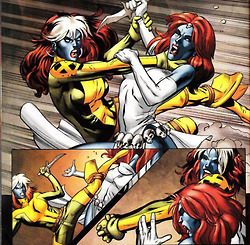 Rogue is in a tricky position. On the one hand, her mutant power is awesome in combat. She can drain the power and abilities of anyone she touches, which enables her to not only weaken her opponents, but also to use their powers against them and others.
Rogue is in a tricky position. On the one hand, her mutant power is awesome in combat. She can drain the power and abilities of anyone she touches, which enables her to not only weaken her opponents, but also to use their powers against them and others.
The downside, of course, is that touch humans at all, because she drains everything from them – as she discovered the first time she kissed a boy back home, putting him in a coma forever. And she can’t touch mutants other than in combat situations for the same reason – as Gambit discovers in the animated series, the time he “steals a kiss” and ends up flat on his back. (I shipped these two like crazy in my teens but on rewatching the first few discs of the cartoon can’t help noticing how much of their “romance” is based on him harassing her, and her being angry and frustrated at his teasing because she knows she can’t actually have a physical relationship with anyone… which makes his behaviour pretty offensive, really. Damn it, past self!)
Anyway, Rogue’s situation leaves her angst-ridden and lonely, covering herself in skin-tight clothing and gloves, a symbolic barrier between her and the rest of humanity. She has serious psychological issues, mostly brought on by the mental influence/invasions of the people whose powers she has borrowed/stolen, as well as the other traumas that have come her way. She also has some pretty messed up associations with romance and sex, which is understandable. What I always liked about her was that she didn’t take it on the chin – she got well and truly angry, and expressed her anger with the world in general. And yes, Gambit is pushy and behaves badly around her, but she gives as good as she gets, yelling at him and fighting with him, calling him on his bullshit. I like to think that it’s this equality between them that made me ship them as a pair, and not JUST his Cajun accent and swishy coat.
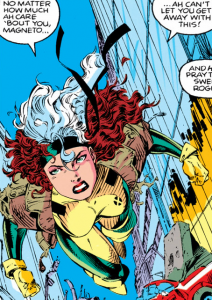 The Rogue I loved as a teenager is snark and fire, anger and untapped, uncontrolled power, rage and angst. I still love her, though I haven’t thought about her and how much she was my favourite in a very long time – so many great female comics characters have eclipsed her since then.
The Rogue I loved as a teenager is snark and fire, anger and untapped, uncontrolled power, rage and angst. I still love her, though I haven’t thought about her and how much she was my favourite in a very long time – so many great female comics characters have eclipsed her since then.
Aspects of the Rogue I think of as “mine” were reflected in the character depicted in X-Men movies of the Noughties. This Rogue, played by Anna Paquin before True Blood, is very young and unsure of herself, deeply conflicted about her powers, but lacks quite a bit of the fire and anger that I associate with the character – a little of that can be seen in the first movie, which I enjoyed very much, especially in her tempestuous friendship with Wolverine, but she becomes noticeably more muted as the movies continue. I was really gutted by the third movie (which as we know made awful decisions about almost all the characters) which had Rogue choose to remove her powers as a resolution to her storyline… and that was it.
See movie Rogue mope.
Yes, the consequences of her powers suck severely, and it’s obvious that she would be tempted to give them up – as she often was in the animated series and indeed in the comics – but to show a young girl voluntarily choosing to give up her power, and the thing that makes her different, seems the height of irresponsible and unpleasant storytelling. To me, Rogue’s character arc is not about getting an easy fix to her problems, it’s about fighting against them, never giving in.What I didn’t properly understand about Rogue until long after I had fallen for her as a character was a) she started off as a villain and b) the reason she had the power of flight and superhuman strength as well as her absorption power in the animated series and the comics was because of a backstory involving Ms Marvel (Carol Danvers), in which Rogue had completely absorbed not only Ms Marvel’s powers, but her personality, who lived on inside Rogue’s head.
Indeed, there was a whole era of the X-Men comics in which Rogue and Carol took turns with Rogue’s body, revealing that it was possible to control Rogue’s absorption powers – Carol could touch people without hurting them if she chose, but Rogue could not.
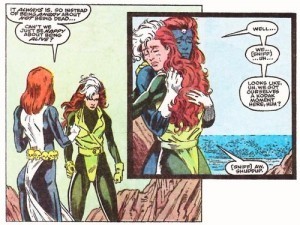 Rogue’s origin as a villain was also tied up with another iconic Marvel woman: Mystique, who took Rogue in as an adopted daughter after she first left home, and turned her to the side of Magneto and the Brotherhood of Evil Mutants. Okay, morally problematic, but how awesome that Rogue’s backstory is one big messy successful Bechdel Test?
Rogue’s origin as a villain was also tied up with another iconic Marvel woman: Mystique, who took Rogue in as an adopted daughter after she first left home, and turned her to the side of Magneto and the Brotherhood of Evil Mutants. Okay, morally problematic, but how awesome that Rogue’s backstory is one big messy successful Bechdel Test?
Several of the more recent animated series have portrayed Rogue in interesting ways – I liked her especially in X-Men Evolution (the X-Men are all high school students) where she was portrayed as an angry goth chick with Mystique issues, a tendency to cross over to the dark side (AKA the Evil Kids High School) and a Daria-like attitude. More recently I have begun watching Wolverine and the X-Men which again puts an older but no less cynical Rogue through angst, betrayal, bashing people up with their own powers and shouting at her friends in her loud Southern accent. All the things she does best.
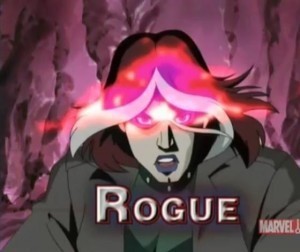 Too often, super heroines are portrayed as (or thought to be) perfect, head girl types: Hermione Granger in a swimsuit. And while I have a great fondness for many of these glamorous, competent characters like Wonder Woman, Storm and Jean Grey, I do still kind of love a heroine who gets messy, yells at people and make mistakes, but is honourable enough to sweep up the glass afterwards and apologise. That’s the thing I find it hardest to forgive about the X-Men movies… Rogue wasn’t given a chance to fix things, or to complete her story arc. Her character was sacrificed to the plot, as the example of the mutant who wished her power away, because she didn’t trust the boy she liked (Bobby/Iceman) to choose her over a girl he could touch.
Too often, super heroines are portrayed as (or thought to be) perfect, head girl types: Hermione Granger in a swimsuit. And while I have a great fondness for many of these glamorous, competent characters like Wonder Woman, Storm and Jean Grey, I do still kind of love a heroine who gets messy, yells at people and make mistakes, but is honourable enough to sweep up the glass afterwards and apologise. That’s the thing I find it hardest to forgive about the X-Men movies… Rogue wasn’t given a chance to fix things, or to complete her story arc. Her character was sacrificed to the plot, as the example of the mutant who wished her power away, because she didn’t trust the boy she liked (Bobby/Iceman) to choose her over a girl he could touch.
*My* Rogue would never do that. She would go kicking and screaming, punching and swearing, and even if she lost her powers (which has occasionally been the case in the comics), she sure as hell would stick around to find some other way of getting in on the action, and helping out her friends. While making snarky comments. Her name says it all: she’s the wild card, not the conformist.
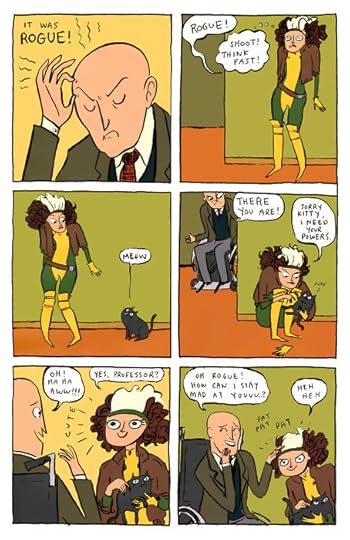
[comic by Kate Beaton from Hark a Vagrant]
Where the Wonder Women Are:
0: Introduction
1: Black Canary
2: Rogue
July 10, 2012
Let’s Talk About Livia Day
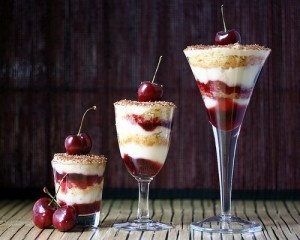 I’m feeling a bit bipolar at the moment, because I’ve spent the last day or two setting up a social media presence of sorts for my crime-writing alter-ego, Livia Day.
I’m feeling a bit bipolar at the moment, because I’ve spent the last day or two setting up a social media presence of sorts for my crime-writing alter-ego, Livia Day.
Oh. Have we not talked about her yet?
My first crime novel, A Trifle Dead, will be published early next year by Twelfth Planet Press, under the name of Livia Day. It’s a fun Hobart-based murder mystery featuring fashion, food and vintage film geekery.
I wanted to differentiate between my fantasy/SF writing and my crime writing, because while they have a lot of crossover appeal, they also have two distinct audiences. I still wish I’d done something with the Shimmaron book to separate my children’s writing from my adult writing, even if it was just slipping in a secret initial, or dropping off one of my surnames. For crime, it felt right to choose a new name, even if the risk is that I lose some of my current loyal readers who don’t realise it’s me.
HEY SWEETIES, IT’S ME!
On the other hand, I didn’t want the hassle stress of actually crafting a properly secret identity. It’s still possible to do that in this day and age – and it’s amazing how many writers, especially women, don’t write under their legal name for all sorts of sensible reasons – but I preferred to try something along the Mira Grant/Seanan Maguire, Marianne De Pierres/Marianne Delacourt model, which means I tell everyone who I am, but still get to be treated as separate entities in library catalogues, etc. Best of both worlds, right?
I’m still figuring it all out. I’m starting to suspect that Livia Day might dress better than me, and that’s a level of commitment to the concept that I don’t THINK I want to allow…
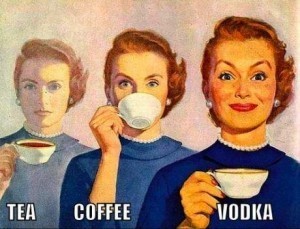 My blog will continue to be its usual mish-mash of everything I care about. I’ll be talking about Livia stuff and Tansy stuff and everything else as it becomes relevant. But I always intended my Tumblr account to be technically for Livia rather than myself, on the grounds that I didn’t want to double up doing the same social media platform for multiple identities – that’s why it’s called Tabitha Darling’s Bedroom Floor, something that hopefully will make sense once you read A Trifle Dead!
My blog will continue to be its usual mish-mash of everything I care about. I’ll be talking about Livia stuff and Tansy stuff and everything else as it becomes relevant. But I always intended my Tumblr account to be technically for Livia rather than myself, on the grounds that I didn’t want to double up doing the same social media platform for multiple identities – that’s why it’s called Tabitha Darling’s Bedroom Floor, something that hopefully will make sense once you read A Trifle Dead!
Livia now has her own Twitter handle too: @liviadaysleuth
She doesn’t have her own Pinterest ID, but I have been keeping a board devoted to A Trifle Dead, so if you want some hints about the book and the sense of style of the characters, you can check it out. See, it’s all so incestuous already!
Twelfth Planet Press have announced a trifle recipe competition, to find fun and delicious recipes to publish in the novel. I hope lots of you will submit!
Over at the Tara Sharp blog, Marianne has interviewed my publisher Alisa about the Deadlines crime imprint, and A Trifle Dead.
July 9, 2012
Agathon #8: The Big Four [1927]
The only vintage cover of this book that doesn’t feel at least vaguely racist
Kathryn and I started out with a challenge to read every book written by Agatha Christie, in order of publication – now we’ve dragged Nick along with us for the ride, and we’re blogging as we go along. We spoil all the things!TANSY:
Is it me or was this a really, really weird story? It’s like all of the early Agatha spy and espionage capers got crammed into a Poirot tale, and he’s spending most of his time pretending valiantly that he’s not in the wrong book. But he so is!
I liked having Hastings back very much, as I’ve missed his voice, though I am a touch irritated that Cinderella was packed off to South America and we don’t get to see her. The bit at the beginning where Hastings jumps off the boat and finds Poirot about to get on a boat himself to go see him is utterly adorable.
But the rest of it? O.M.G.
Is this the first time that Christie has written Poirot a story that feels like it’s supposed to be his last? Actually you could probably argue that The Murder of Roger Ackroyd had that feeling, but this one seems designed as a swansong – and not a very successful one considering that the next novel up is also a Poirot story.
I’ve left it a bit too long between reading the book and reviewing it, but the whole Big Four guff wasn’t that much clearer while I was reading the thing – the whole elaborate story felt like a massive fake-out, and it was all the more disappointing that it was in the end quite a serious threat.
The relationship between Poirot and Hastings does feel very real and earnest, and is the only thing pinning the flimsy, melodramatic plot to the pages. The scenes where Hastings believes his wife has been kidnapped and that he has to betray Poirot (but still wants to warn him) are marvellous, very heartfelt and chilling, and make the book worthwhile, but the rest of it is pretty ridiculous.
My headcanon will remain that the whole thing was a massive con set up by Cinderella as an entertaining jape for her husband’s birthday, and to get him back with Poirot because he had been so sad without him and their adventures.
See what I mean?
KATHRYN:No, Tansy, it’s not just you. This story is very weird. I do actually remember reading this back in my unformed years, when i just read whatever Christie was available in the library. So I was already expecting ‘cracked out’ going in (and was also really intrigued that Christie had followed up the the skill and subtlety of Ackroyd with ‘cracked out’). However, even with forewarning, ‘The Big Four’ appeared even more cracked out than I had remembered.
BUT! BUT! It’s not Christie’s fault! Well it’s still her fault, but there was a reason for this book, as was explained to me in the afterward that accompanied my version of the book (my version lives in a 1920s omnibus with Ackroyd and The Blue Train). Christie had lost her writing mojo, after the death of her mother and the breakdown of her first marriage. She also had a book contact to fill, and needed money. Therefore she took a bunch of short stories already written, which all referenced the idea of The Big Four, wrote some filler and an ending, and the rest is history! So, yes, the book is awful, but it is justifiably awful, and well done her on fulfilling her contract!
Learning this made me forgive a lot of the issues with the book, and it was a relief to learn that my main impression – that story felt like a random collection of short stories, rather than a novel proper – was completely reasonable.
It is also nice to have Hastings back, although he is an awful arse for a lot of the story. I was NOT impressed that he forgot about his wife for months on end. I’m sure Cinderella was perfectly able to take care of herself, but I did feel it reflected a rather large character flaw on Hasting’s – particularly when he goes google eyed over lovely young stenographers at the drop of a hat.
It was also lovely to see portrayal of a Brilliant Lady Scientist. Madame Olivier may have been nuts (and evil), but she’s also kinda Madame Curie on steroids, so I’m happy to have her. It almost makes up for the rather stereotypical portrayal of the Russians, Chinese and French…
So I’m not as disappointed with this book as I might have been, though I do hope it remains an oddity rather than something Christie revisits again.
So, Agatha Christie gets her Sax Rohmer on. And her Conan Doyle. And a few others that haven’t lasted.
Much as I love (some of) the pulps the Big Four owes life to, I really didn’t like this book much.
It has many of the tropes of the pulps – ill-defined weapons that could change the course of naval war, Russian exiles, fancy killing devices, masters of disguise, inscrutable oriental master villains, plots to control the world, even an underground base from which to rule – the ending is almost like a Bond film in some ways.
The book feels almost completely “un-Christie”. Even though she often broke out of the “cosy” mystery genre for which she’s mostly remembered, it still feels very strange when she departs from the genre as thoroughly as she does in the Big Four.
The Big Four is competently written although, while the individual linked mysteries that make up the book are generally competent, I had no connection with the overall plot about the Big Four bad guys trying to control the world. It seemed excessive and overly flamboyant for both Poirot and for Christie herself, who is much better when the motivations of her villians are more venal.
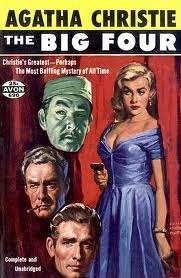 There were some highlights, too. I kind of liked Madame Olivier – but Countess Vera Rossakoff, the fallen Russian adventuress, has always been one of my favourite side characters in the Poirot stories (as much as she owes to Irene Adler). She’s one of the strongest of Christie’s female characters, for mine, in that she acts through her own agency and largely seems in control of the events and not, as many others were, a mere puppet carried along by the events surrounding her.
There were some highlights, too. I kind of liked Madame Olivier – but Countess Vera Rossakoff, the fallen Russian adventuress, has always been one of my favourite side characters in the Poirot stories (as much as she owes to Irene Adler). She’s one of the strongest of Christie’s female characters, for mine, in that she acts through her own agency and largely seems in control of the events and not, as many others were, a mere puppet carried along by the events surrounding her.
COMING NEXT:
The Mystery of the Blue Train (1928)
[Hercule Poirot]
The Seven Dials Mystery (1929)
[Eileen “Bundle” Brent, Superintendent Battle]
Partners in Crime (1929)
The Mysterious Mr Quinn (1930)
July 8, 2012
Where the Wonder Women Are #1: Black Canary
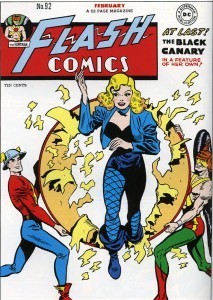
Golden Age Black Canary: Dinah Drake.
One of the all-time greats, Black Canary is one of those characters whose brilliance might not be evident to people based on her appearance.
Like Superman with his underpants on the outside, Dinah Drake/Lance is hampered by the fact that she is “the one with fishnets” which does mean that as soon as someone starts drawing or dressing like her, it’s amazingly easy to make her look like a stripper.
But Dinah is a badass. While she does occasionally (on and off) display the superpower of the “canary cry,” a sonic boom to fell her enemies, her main abilities come from intense martial arts training. She was the character called in to “sub” for Wonder Woman as the token female founder of the Justice League when the characters were rebooted after the mid-80’s Crisis (and Wonder Woman was deemed too young/new to have had such an honour). Later, she really was a founding member of the most iconic all-female superhero team of all time, Birds of Prey – twice, thanks to the New 52. Oh, and she rides a motorbike like you wouldn’t believe.
Dinah’s story begins back in the 40’s where she was Dinah Drake, a black-haired florist by day and blonde crime fighter by night, member of the Justice Society, the first superhero team. She romanced and eventually married police detective Larry Lance, and the two of them were brought back in the 60’s as Earth 2 characters, when it was decided that the Justice Society was a parallel earth version of the Earth 1 Justice League rather than its predecessor (one of those problems that has to be dealt with in comics when characters are apparently ageless for decades).
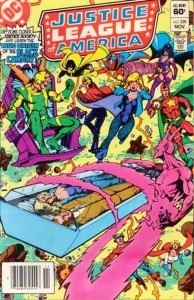 In 1969, Larry Lance was killed of radiation after a battle, and Dinah Lance responded to this grief by switching universes, joining the Justice League, developing the ultrasonic Canary Cry, and romancing Oliver Queen AKA Green Arrow, he of the pointy beard and Robin Hood costume.
In 1969, Larry Lance was killed of radiation after a battle, and Dinah Lance responded to this grief by switching universes, joining the Justice League, developing the ultrasonic Canary Cry, and romancing Oliver Queen AKA Green Arrow, he of the pointy beard and Robin Hood costume.
But in 1983, one of DC’s best and most bonkers plot twists was revealed, and it still remains one of my favourite comics moments of all time. Black Canary was not actually Dinah Drake-Lance. Larry and Dinah had a daughter in the 50’s, called Dinah Laurel Lance, who was cursed by one of the Justice Society villains with an uncontrollable ‘canary cry’. She had been kept in suspended animation for twenty years, only the kind of suspended animation that allows you to grow to adulthood and look just like your mother, including a blonde wig.
After Larry Lance was killed, Dinah Drake-Lance discovered she was dying of the same radiation, and arranged for her memories to be downloaded into the body of her daughter. When Dinah Laurel Lance discovered this truth about her mother, her first thought was that she no longer had to feel guilty about falling in love with Green Arrow so soon after the death of her “husband” and not the alarm that she has a whole lot of memories of in fact BEING IN LOVE WITH HER FATHER.
Ahem. The whole thing was retconned away three years later when Crisis hit the DC universe, Black Canary was just the daughter of a cop and her mother was the former Black Canary who passed the baton on to her and then died of cancer. Kind of boring by comparison, and I was outraged about this for years, though I must admit that now I come to actually explain it, I can see their point.
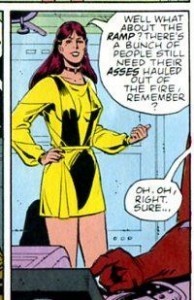
Laurie Juspeczyk as Silk Spectre, in Watchmen
It’s worth noting at this point that Black Canary was one of two characters that Alan Moore used as the model for his Silk Spectre I & II in Watchmen, in which he explored the dark side of a daughter inheriting a superhero name from her mother, and threw in a bunch of rape and daddy issues to go with it. I adore Laurie (omg I just realised the significance of her name) but she has a whole lot less agency in Watchmen than her DC counterpart. The design of the Silk Spectre costumes for both Laurie and her mother Sally address the issues of the fishnet tights: Sally wears actual suspender stockings and appears to relish the sexuality expressed through her costume; Laurie has bare legs and usually looks uncomfortable with her own body.
The new Dinah Laurel Lance, I have to admit, is a far more empowered character than she was pre-Crisis. Her training is something she chose to take on herself, against her mother’s wishes, choosing a variety of trainers (including her mother’s former colleagues from the Justice Society) to build her skills.
Sadly in the post-Crisis world, Dinah Drake herself retrospectively becomes something of a horrid nagging mother as opposed to a figure of inspiration… an worth considering in comparison to the portrayal of Sally & Laurie Jupiter in both Watchmen and the new Before Watchmen series by Darwyn Cooke in which the relationship is just as toxic but opposite: Sally pressures Laurie to follow in her footsteps, forcing her through an obsessive training regime.
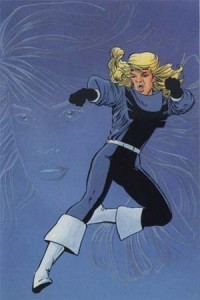
Why is it that whenever the superheroines are given pants, they are ugly pants?
In any case, the only active Black Canary post-Crisis is Dinah Laurel Lance. She briefly lost the fishnets & blue/black jacket combo in the late 80’s, taking on instead an outfit which defied ugliness even for a superhero costume designed in the 80’s, and appeared in the revamped, comedic version of the Justice League as the first and only female member, only to bow out later after the team went “international” – after which there was always multiple female characters in the team, right up to the point where the Justice League was reinvented in the mid 90’s by Grant Morrison, who reinstated Wonder Woman as the only woman in a sea of male muscle. Yes, I’m still bitter.
Dinah remained on the Justice League books as an occasional member, dropping in to help out from time to time. Meanwhile, Black Canary suffered as a character – both literally and figuratively – mostly being relegated to the role of supporting character in Green Arrow’s book. Even her new florist shop, ‘Sherwood Florist,’ reflects his character and not her own. She was put through the physical wringer in a quite awful mini-series called The Longbow Hunters, which can be seen as an example of the women in refrigerators trope, though Dinah wasn’t killed – and according to the writer later, was not raped, though this was assumed to be the case by many readers.
In any case, she was tortured badly enough to lose her canary cry, which suggests a certain degree of trauma. As a supporting character of an increasingly grim and gritty Green Arrow, she also dealt with his cheating on her, and other unpleasantness. After Green Arrow was killed off, Dinah then discovered that he had a son, Connor Hawke, she had never known about.
The issue in which Connor brings the news to Dinah is an example of how badly Dinah has been treated over the years, particularly by writers and artists who saw her as a Green Arrow appendage, and who couldn’t see past the fishnets. I’m all for the fishnets as part of her classic costume, because it’s a classic costume, and because they can be drawn so as to make her look cute and fun, not as a burlesque act. But in this case, she is shown off duty, with her short black Dinah hair, STILL WEARING THE FISHNETS as a young man she doesn’t know comes to her house and talks to her. She is shown to grieve for her lover while wearing fishnets and little else. It made no sense, and showed an utter lack of respect. Yes, I can buy someone wearing fishnets instead of trousers to fight crime, but no, I can’t buy them answering the door while wearing them (and little else) casually around the house.
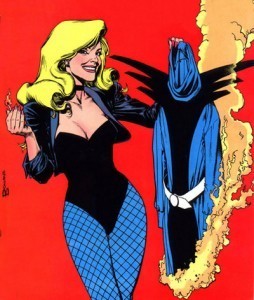
Dinah burns her late 80′s costume. It’s hard to argue with her.
Which goes some way to expressing how complex the issues are surrounding superhero costumes, especially for women. They are ridiculous. I mean, they’re ALL ridiculous. Nothing shows this as easily as the live action movies where they try to put the actors in anything even resembling what the characters wear in the comics. But the fact is, a costume like Black Canary’s puts her at the mercy of the artist… but if they steer too far away from the original look, then she might as well be some other character, and as with Wonder Woman herself, no other costume has ever stuck around long enough to provide an alternative.
Yes, the fishnets are camp. But as soon as the artist gets either self-conscious or over excited by the implications of the fishnets, disaster ensues. The best way to draw Black Canary is with a ‘what, you don’t think I’m fully dressed? Screw you,’ attitude. Because as soon as she’s drawn as if she’s posing seductively for the male gaze, she doesn’t look like Dinah any more.
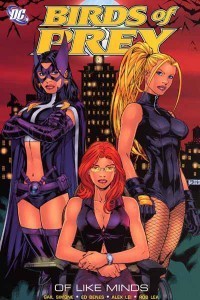 At least things were looking up, writing-wise. With Green Arrow dead, there was a chance for Dinah to be her own character again, in a more significant title than the occasional short mini-series. She formed a partnership with Oracle, AKA Barbara Gordon, who had risen through her own lengthy “crap they put female superheroes through” and was now a wheelchair-awesome computer guru. With Babs as the brains and Dinah as the brawn, they fought crime as the Birds of Prey, adding all manner of mostly-female combatants to their team over the many, many years they were a successful comic.
At least things were looking up, writing-wise. With Green Arrow dead, there was a chance for Dinah to be her own character again, in a more significant title than the occasional short mini-series. She formed a partnership with Oracle, AKA Barbara Gordon, who had risen through her own lengthy “crap they put female superheroes through” and was now a wheelchair-awesome computer guru. With Babs as the brains and Dinah as the brawn, they fought crime as the Birds of Prey, adding all manner of mostly-female combatants to their team over the many, many years they were a successful comic.
Created by Chuck Dixon, the team was at its creative height under the pen of Gail Simone, whose reputation as a writer for DC Comics is largely built on the success of Birds of Prey – though her Secret Six and Wonder Woman runs were also hugely popular, and more recently she has helped to relaunch Barbara Gordon as a post-wheelchair Batgirl.
Through Birds of Prey, a variety of different, more modern costumes were tried for Dinah, including different ways of wearing her blonde hair (no longer a wig) and elements of the old costume, but funnily enough, the more ‘contemporary’ they went with her, the sillier the fishnets looked.
 I adore the partnership of Green Arrow and Black Canary when it’s written well, as they can be a fun, action-packed couple. Still, it was hard not to resent it when Oliver Queen came back from the dead, and Dinah left the Birds of Prey to team up with him again. At least this run was billed as Green Arrow/Black Canary (shared billing!) and featured such marvels as the Amanda Conner designed tongue-in-cheek Dinah Lance wedding dress, an all white extravaganza of fishnets and corset which somehow worked, because Dinah and Ollie couldn’t possibly have a normal wedding, in any case. And this time around, gratuitous fake deaths aside, they had a whole lot more fun together.
I adore the partnership of Green Arrow and Black Canary when it’s written well, as they can be a fun, action-packed couple. Still, it was hard not to resent it when Oliver Queen came back from the dead, and Dinah left the Birds of Prey to team up with him again. At least this run was billed as Green Arrow/Black Canary (shared billing!) and featured such marvels as the Amanda Conner designed tongue-in-cheek Dinah Lance wedding dress, an all white extravaganza of fishnets and corset which somehow worked, because Dinah and Ollie couldn’t possibly have a normal wedding, in any case. And this time around, gratuitous fake deaths aside, they had a whole lot more fun together.
More recently, in the new 52, there is a new Birds of Prey, with Dinah as its leader. I’ll confess I haven’t been reading it – Batgirl might be involved, but the team didn’t make sense to me in its first issue without Oracle at the heart of it, and I missed the old version too much to keep trying. I can forgive the new Batgirl for all the changes, but I couldn’t make the leap to Birds of Prey. This makes me sad.
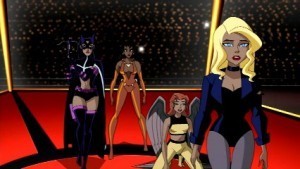 Meanwhile, Black Canary, with a design owing more to the original 1940′s costume than anything else, appeared several times in the series Justice League Universe, notably starting the Green Arrow relationship all over again, but also forming an alliance if not quite friendship with Huntress, one of the Birds of Prey regulars. All the best elements of Dinah – her martial arts training, her canary cry, her motorbike fixation, her iconic look and her snarky tone, are right there on the screen. She has also appeared in various of the Batman series, notably Batman: the Brave and the Bold, and I was excited to hear that she appears on Young Justice, training a new generation of superheroes in the art of the judo throw.
Meanwhile, Black Canary, with a design owing more to the original 1940′s costume than anything else, appeared several times in the series Justice League Universe, notably starting the Green Arrow relationship all over again, but also forming an alliance if not quite friendship with Huntress, one of the Birds of Prey regulars. All the best elements of Dinah – her martial arts training, her canary cry, her motorbike fixation, her iconic look and her snarky tone, are right there on the screen. She has also appeared in various of the Batman series, notably Batman: the Brave and the Bold, and I was excited to hear that she appears on Young Justice, training a new generation of superheroes in the art of the judo throw.
It’s certainly better than the shortlived Birds of Prey TV series, which had a fairly credible Oracle and Huntress, but chose for some strange reason to change Dinah to a nervous teenager, losing pretty much all the cool elements of her character from the comics, so that she was unrecognisable to fans.
 While Green Arrow/Oliver Queen was a regular character on Smallville for several years, notably not wearing his silly beard, Dinah herself only appeared occasionally, in a costume that really didn’t convince anyone that wearing fishnets while fighting crime was a good idea, and Oliver is paired up romantically with Chloe. [edit: sorry for disappointing anyone with this sentence as previously written where it implied Dinah/Chloe were canon in Smallville. I would TOTALLY go back and watch that...] I wasn’t watching any more by the time she came along, so feel free to correct me on this! Apparently there was a nod to the existence of her mother, Dinah Drake, as an original member of the Justice League.
While Green Arrow/Oliver Queen was a regular character on Smallville for several years, notably not wearing his silly beard, Dinah herself only appeared occasionally, in a costume that really didn’t convince anyone that wearing fishnets while fighting crime was a good idea, and Oliver is paired up romantically with Chloe. [edit: sorry for disappointing anyone with this sentence as previously written where it implied Dinah/Chloe were canon in Smallville. I would TOTALLY go back and watch that...] I wasn’t watching any more by the time she came along, so feel free to correct me on this! Apparently there was a nod to the existence of her mother, Dinah Drake, as an original member of the Justice League.
Rumour has it that the new Green Arrow TV series, “Arrow,” owes a lot more to the Smallville version of Ollie than anything out of the comic books, but rumour also has it that Dinah Lance, at least, is a character cast in the show. No confirmation yet as to whether this Dinah is our girl Black Canary, or just some brunette florist.
But I really hope she rides a motorbike.
Where the Wonder Women Are:
0: Introduction
1: Black Canary
Where the Wonder Women Are: Introduction
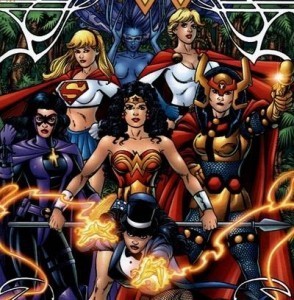 The thing about female superheroes is, there’s lots of them in comics. TONS of them. The reason it seems like maybe there aren’t is due to many factors: a lack of solo titles in the DC/Marvel stable, the tendency to kill off said female superheroes at a faster rate than male superheroes (and not to bring them back as often or as quickly), a lack of female creators at both companies, and in many cases, a bunch of creators who write and draw female superheroes so appallingly that it leads readers to believe that the character is somehow at fault.
The thing about female superheroes is, there’s lots of them in comics. TONS of them. The reason it seems like maybe there aren’t is due to many factors: a lack of solo titles in the DC/Marvel stable, the tendency to kill off said female superheroes at a faster rate than male superheroes (and not to bring them back as often or as quickly), a lack of female creators at both companies, and in many cases, a bunch of creators who write and draw female superheroes so appallingly that it leads readers to believe that the character is somehow at fault.
And that’s only scratching the surface. There are also legacy issues, such as the problem that the majority of recognisable female superheroes are spin offs from far-more recognisable male superheroes, or have deeply sexist origin stories to overcome, or are still judged by the way their character was written as ineffectual in the 60′s, a time when every superhero team had a single female character and she was the one who got to make the tea. Even the costumes become far more problematic and political with the women, with fans more likely to be judgemental about changes from tradition, and it’s sad how many current artists in the industry are still likely to take historically sexy, impractical or skimpy costumes and make them ten times more sexualised or impractical in the name of “tradition.”
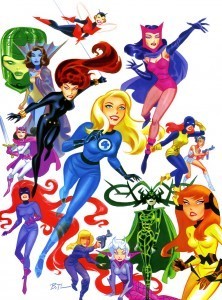 And there’s the elephant in the room, which is that titles featuring female led characters often don’t receive enough reader support to be viable. Though as you might have guessed, I don’t think it’s that simple, and the current success of Batwoman goes to show that with publisher support, with a fantastic creative team and cool storylines, it doesn’t always have to be that way. But of course there are a whole lot of comic book graveyards that tell another story…
And there’s the elephant in the room, which is that titles featuring female led characters often don’t receive enough reader support to be viable. Though as you might have guessed, I don’t think it’s that simple, and the current success of Batwoman goes to show that with publisher support, with a fantastic creative team and cool storylines, it doesn’t always have to be that way. But of course there are a whole lot of comic book graveyards that tell another story…
After the fun we had discussing this issue at our Where are all the Wonder Women panel, I wanted to to write something positive about women in comics, about the awesome female characters that have been around over the years, how they have been reinvented or reinterpreted across different media, and their potential to be the iconic Wonder Women of the 21st century. I’m not going to be providing comprehensive histories of the characters (unless I really can’t help it), because that’s what Wikipedia is for, but trying to provide my own take on who she is, which version of her I like best, and why she’s awesome. Some ranting might slip through, but the plan is to be positive. Really. Truly.
And yes, I am going to talk about Wonder Woman, herself, but not yet. There’s some other fun women to introduce you to first…
Mothers and Daughters, Battle-Embroidery and Bears
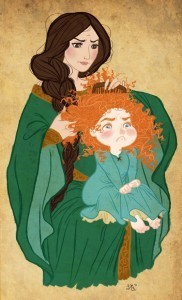 [Contains many, many spoilers for Disney/Pixar's Brave]
[Contains many, many spoilers for Disney/Pixar's Brave]
I took Raeli to see Brave yesterday and was so excited to come and write a detailed post about how seriously this movie takes the job of royal women (both queens and princesses) among the other wonderful things this movie does. It turns out this is exactly what was intended, as I read on Blue Milk today:
“…if you look at real princesses, they were basically working girls. Pampered in their times maybe, but nonetheless, they had a job to do for their kingdoms, whether it be as a diplomat or as a bargaining “tool” to bring kingdoms together in alliance. I think there was little waiting around for true love and eternal happiness in their lives. And back in the days in which the fairy tales of old were written, marriage was one of the most important jobs of a princess. It was part of their job, not simply a romantic notion.”
[Brenda Chapman, one of the original writers on the Brave script, who devised the character of Princess Merida]
Brave is a fun, action-packed movie, and yes, as said in many places elsewhere, it’s a story about a mother-daughter relationship, which is rare in fairy tale movies and adaptions. But what I was most impressed with is that it is not a story about a princess who is totally into cool boy things like bows and arrows and horse-riding, and hates girly things like embroidery, and whose mum is a total drag about wanting her to be ladylike. If it had been that movie, I would not have loved it nearly as much.
Brave is as much Queen Elinor’s story as Princess Merida’s, and coming to it as a mother I was delighted to have so much complexity in the portrayal of the Queen. We see how important her role and indeed job in the kingdom is – while her husband is the warrior king who can speak to the other chiefs on their level, she is the diplomat and peacemaker who keeps them all on an even keel. When she is taken out of the equation, the clans fall apart in anarchy and warfare (as they have all presumably forgotten to bring their own diplomatic, peacekeeping wives with them – bad move there!).
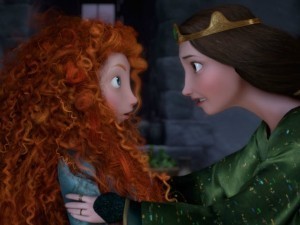 I liked very much that Elinor and her point of view are respected throughout the story – and that the audience is allowed to sympathise with her even when she is thwarting the heroine. This is further conveyed through the portrayal of Merida’s father, who is a marvellous character in his own right. His relationship with Merida is more light-hearted than that with her mother – he is the “fun” parent who makes snarky commentary about her potential suitors, supports in her love for “unladylike” pursuits, and thinks she is basically awesome when she flouts the rules to try to win her own hand in marriage at an archery contest.
I liked very much that Elinor and her point of view are respected throughout the story – and that the audience is allowed to sympathise with her even when she is thwarting the heroine. This is further conveyed through the portrayal of Merida’s father, who is a marvellous character in his own right. His relationship with Merida is more light-hearted than that with her mother – he is the “fun” parent who makes snarky commentary about her potential suitors, supports in her love for “unladylike” pursuits, and thinks she is basically awesome when she flouts the rules to try to win her own hand in marriage at an archery contest.
However, and this is the important part of the grown up thread of the story – he can afford to be that fun parent, because Elinor is there picking up the slack, just as he can fight happily with the other clan chiefs, and muck around. He has Queen Elinor there to tidy up after him, and his enjoyment of Merida’s wilder tendencies means that his wife can’t afford to enjoy that aspect of their daughter at all. She always has to be the tough parent, the one who draws the line and thinks about future consequences – and while she and her husband love each other very much, you can see that the only reason this hasn’t strained their marriage overly is because Elinor is willing to put up with it. I got a bit cross on her behalf, though!
There’s a dual perspective going on for the entire story. It’s clear that as Merida and Elinor both complain bitterly about how the other doesn’t listen to them and can’t understand them, they are both failing to empathise enough with each other: Merida because she is young and hot-headed and wrapped up in the unfairness of being pushed into a role that does not suit her temperament; Elinor because she has a job to do, and is trying to prepare Merida for that same job. The anger and resentment built up between these two women who love each other desperately, but have reached the point of no return in their relationship, is symbolised by a quite awful scene where Merida slashes her mother’s tapesty depicting the family (in which Merida is depicted as the perfect tidy princess she isn’t), and Elinor responds by hurling her daughter’s bow on the fire.
(worth noting that Merida flounces off crying, miserable at what her mother has done and not her own actions, while Elinor, being the grown up, is immediately horrified at her own actions and tries to undo what she has done immediately – I think that’s important)
I love that neither mother nor daughter is completely wrong or right – their relationship has to change, and they both need to become more flexible about their ideas, and it takes a colossal mistake on Merida’s part to make that happen.
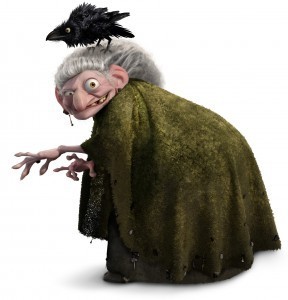 Enter the witch. Who, much like Merida and Elinor themselves, is a complete subversion of the kind of witch we are accustomed to in Disney movies. Instead of being a malign force, she is a batty old wood-carver who lives deep in the forest, and (it becomes rapidly obvious) only does magic or craft relating to bears. Thus, when a prince of ancient times asked for the strength of ten men… she turned him into a bear. And now, when Princess Merida begs for a spell to change her mother (hoping to change her mind and/or attitude towards the compulsory marriage deal hurtling towards them), the witch turns her into a bear. Obviously.
Enter the witch. Who, much like Merida and Elinor themselves, is a complete subversion of the kind of witch we are accustomed to in Disney movies. Instead of being a malign force, she is a batty old wood-carver who lives deep in the forest, and (it becomes rapidly obvious) only does magic or craft relating to bears. Thus, when a prince of ancient times asked for the strength of ten men… she turned him into a bear. And now, when Princess Merida begs for a spell to change her mother (hoping to change her mind and/or attitude towards the compulsory marriage deal hurtling towards them), the witch turns her into a bear. Obviously.
The scenes in which Queen Elinor are a bear represent some amazing animation and one of the best “virtual performances” I’ve ever seen. There is so much subtlety in how she deals with, basically, the body horror of turning into a wild creature, and the ways in which she tries to keep some semblance of humanity. But it’s important that, while losing her mother to the shape of a bear is a horrible learning experience for Merida, it’s also an educational experience for her mother, who discovers first-hand that her daughter has managed to acquire all kinds of useful survival traits while running around the forest with her bow and arrow.
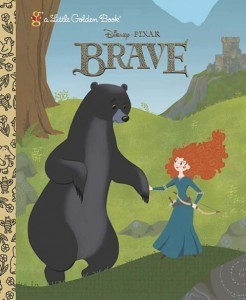 The climax of the movie, then, is a series of quite emotional concessions between Merida and her mother – Merida realising how important her theoretical marriage is to keeping the clans from killing each other, Elinor realising that her daughter may need to find her own path to being a good Queen, and both of them learning the art of compromise. Plus, bear antics, both frightening (for seven year olds) and amusing.
The climax of the movie, then, is a series of quite emotional concessions between Merida and her mother – Merida realising how important her theoretical marriage is to keeping the clans from killing each other, Elinor realising that her daughter may need to find her own path to being a good Queen, and both of them learning the art of compromise. Plus, bear antics, both frightening (for seven year olds) and amusing.
Then there’s the tapestry. When we discussed craft cliches at one of the several crafting panels I was on at Continuum 8, I mentioned the idea of embroidery being synonymous with “useless” princess skills, and the way that fictional young ladies so often were given a hatred for embroidery (or an inability to embroider) as a fictional shorthand for “she’s cool like a boy.” That isn’t what happens with sewing in this movie.
The witch leaves Merida a message, that she must mend what is broken to stop her mother remaining a bear forever – and Merida immediately assumes that she has to fix the tapestry she slashed. Everyone ELSE in the cinema (well, probably the grown ups) knows that it’s the relationship between she and her mother that really has to be mended, but the tapestry so beautifully symbolises that anyway that the two ideas co-exist very effectively. And when Merida does mend the tapestry (in the midst of many other dramas) she does so on horseback, riding madly through the forest in order to protect her mother from the bear-mad men of the clans, including Merida’s own father.
I love this because there’s never a hint that Merida can’t sew. Of course she can bloody sew. Also she can do it under battle conditions, because she’s awesome.
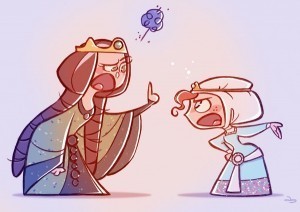 Clothes and hair are also used symbolically through the film, adding yet another layer of meaning over the mostly-straightforward plot. Merida’s hair is certainly a character in the story in its own right (as is the astounding scenery), and the outfit which her mother chooses for “the gathering” uses all the medieval traditions of hiding women, wrapping her hair out of sight. (Merida pulling one red curl out of the veil looks ridiculous, and is meant to – she is spiting her mother, but looks silly doing it) Likewise, the dress chosen by Elinor for this event is too tight, literally constraining Merida, and when she goes on her archery rampage to prove a point, the dress has to give at the seams: again, quite literally.
Clothes and hair are also used symbolically through the film, adding yet another layer of meaning over the mostly-straightforward plot. Merida’s hair is certainly a character in the story in its own right (as is the astounding scenery), and the outfit which her mother chooses for “the gathering” uses all the medieval traditions of hiding women, wrapping her hair out of sight. (Merida pulling one red curl out of the veil looks ridiculous, and is meant to – she is spiting her mother, but looks silly doing it) Likewise, the dress chosen by Elinor for this event is too tight, literally constraining Merida, and when she goes on her archery rampage to prove a point, the dress has to give at the seams: again, quite literally.
But Merida’s own outfit of choice, apart from being a more flattering colour, isn’t especially immodest. She’s not running around in her underwear, or in trousers. It’s just a roomy, more lived-in dress, one in which she can climb a cliff, ride a horse and shoot as many arrows as she likes. It’s comfortable, and it’s important to note that one of the concessions that Elinor has to not only allow but embrace, is that her daughter should not have to be uncomfortable in order to be a good Queen someday.
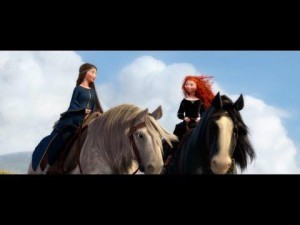 When Elinor finally returns to her human form, her hair is wild and unkempt – unbraided for the first time in the story. Later, the final shot of the movie is Merida and Elinor riding companionably together, along the beautiful animated Scottish landscape, and while Elinor’s hair has been tamed and brushed since her recovery from metamorphosis, neither is it bound as tightly as it was earlier in the film.
When Elinor finally returns to her human form, her hair is wild and unkempt – unbraided for the first time in the story. Later, the final shot of the movie is Merida and Elinor riding companionably together, along the beautiful animated Scottish landscape, and while Elinor’s hair has been tamed and brushed since her recovery from metamorphosis, neither is it bound as tightly as it was earlier in the film.
There are many great things about the story I haven’t mentioned, including a whole lot of funny lines and subplots, the battle sequences, and the most excellent ninja little brothers. I haven’t talked about Merida’s combination of warrior reflexes and natural fear reactions, and the way that it being an adventure story about a mother and daughter allowed the daughter to be afraid of things without that being a statement on the weakness of women. It’s a wonderful, wonderful film. I didn’t expect to have quite as strong an emotional response to it as I did have – and so glad I saw it with my daughter, cuddling her when the scary bear bits were scary, and holding her hand.
At the end, she said with satisfaction, “I will never get tired of watching that.”
I think that’s true for me, too.
July 7, 2012
Clarion Write-a-thon – the third 5000 – RESEARCH IS KEY APPARENTLY WHO KNEW
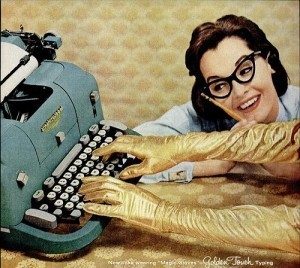
I keep lurching between thinking that I shouldn’t be writing at all right now, or that maybe I should have given myself a more hardcore writing challenge. My big word for the week was ‘research’. The book that I’m writing right now, which may or may not be called Flavia Wednesday, and I first got the spark of the idea for it around January this year.
Normally I have so many novel projects backed up that it takes at least 2-4 years from the initial spark to actually getting to write the dratted thing, and I loved the idea of writing something while it was still “fresh.” But of course, freshness isn’t everything, and those 2-4 years often allow for a lot of quiet background thinking, character association, and casual research. Which I haven’t done.
And as if that wasn’t bad enough, this book is rapidly linking up to all these other historical/steampunk YA plots in my head, forming a universe of other novels, and that makes the worldbuilding all the more essential. Because it’s not actually Victoriana set in OUR history, that would be far too easy. It’s an amalgam of two completely different time periods and storytelling traditions, and there’s building a magic system from scratch and, and, and – is it any wonder that I’m finding it tricky to get my characters out of the dungeon I locked them up in last week?
They might have to sit down there for a while as I figure out all the complicated things.
15209 / 30000 words. 51% done!
Halfway is halfway, and at the three week mark that’s exactly where I should be. But I might have to step up the action if I want to hit my REAL goal for this write-a-thon, which is to get the momentum of the novel flying. The lack of ground under my feet could be what’s slowing me down…
A sample of this week’s writing:
Trapped, then. Flavia tasted the tea. This, at least, was good, though it was milkier than she liked. “The whole household travels that way?’ she asked finally. “But how on earth does Lady Carolinge stand it?”
“Mostly she pretends it isn’t happening,” said Perrault with something of a naughty schoolboy look upon his face as he finished his cake and reached for another piece. Mrs Brundage rapped his knuckles, but managed to look kind as she did so. “Then she claims a sick headache and takes to her bed for three days afterwards, just to remind my brother that he shouldn’t put her through it very often.”
“You’ll find none of that anti-witch sentiment in this house,” Mrs Brundage said firmly. “Our mistress, Lady Mortmain, won’t stand for that sort of nonsense.”
Yes, you can tell it’s a real Tansy book because people are drinking tea!
—
If you want to encourage my Clarion Write-a-thon campaign, please consider donating a little something in my name over here. Thanks so much to those who have already donated, I really appreciate it. All funds go towards the Clarion West writers workshops, a great cause!

